| 001
|
INTRODUCTION
Disabled Persons as Leaders in the Problem-Solving Process
This is a book of true stories about people's creative search for
solutions. Written for disabled persons and their relatives, friends,
and helpers, its purpose is to share exciting, useful ideas, and to
spark the reader's imagination: to stimulate a spirit of adventure!
This book differs from most manuals on disability aids and equipment in 4
basic ways:
1. We make an effort to put the person
and the process before the product. The 50
chapters cover a wide selection of disability aids that are relatively easy
to make at home or in a village. But in presenting each innovation, emphasis
is put less on the end-product (however important) than on the
cooperative process of discovery.
In this approach, the disabled person (and/or family members) often
takes the lead, working as a partner and equal with service providers,
technicians, or local crafts-persons. With this sort of
partnership approach, results tend to be more enabling than when
assistive equipment is unilaterally prescribed or designed.
2. Our goal is not replication, but
rather adaptability and shared creativity.
True, most aids shown here can be easily replicated (copied exactly) at low
cost at home or in a village workshop. However, placing strong emphasis on
replication can be counter-productive . . . especially in the field
of rehabilitation where the needs, possibilities and dreams of each
disabled person are different. Too often, the routine construction of
standardized designs contributes to a habit of trying to adapt the
disabled person to the assistive device, rather than trying to
adapt the device to the disabled person.
Therefore:
Our objective is not to catalogue a set of aids and equipment to be
copied,
but to share an EMPOWERING PROBLEM-SOLVING APPROACH.
3. In most examples in this book, we start by
looking at an individual disabled person. Placing that individual as
central to the problem-solving process, we explore her or his unique
combination of wishes and needs. Then we describe the cooperative,
trial-and-error methods used in designing and testing possible solutions.
The problem-solving is ongoing and open-ended. It may include anything from
learning new skills or modifying the environment, to the invention or
adaptation (or elimination) of an assistive device.
4.Most of the rehabilitation workers and technicians
responsible for the innovations in this book are themselves disabled.
Because they too have a disability, they are more inclined to work with a
disabled "client" as a partner and equal in the problem-solving adventure.
Also, being disabled, they often have insights (an insider's view) leading
to new approaches that help enable the disabled individual with whom they
work.


PROJIMO
Most of the innovations explored on these pages were created in
PROJIMO: Program of Rehabilitation Organized by Disabled Youth
of Western Mexico. This small community-oriented program is based in
Ajoya, a village of 1000 inhabitants in the mountains of Western Mexico. The
author of this book - himself disabled (see
Chapter 11) - has worked as a facilitator and advisor to the program
since it began in 1981. On the next page we give a brief account of how
PROJIMO differs from similar community programs. For more information on the
program we suggest you look at Disabled Village Children, a
handbook which grew out of PROJIMO (see page 343).
Or write to us at HealthWrights. |
| 002
|

How PROJIMO Differs from Many CBR Programs
PROJIMO - the program in Mexico run by disabled villagers where most of
the innovations in this book come from - differs from many Community Based
Rehabilitation (CBR) programs in that:
 | PROJIMO was started by, and is organized and run by disabled
villagers. |
 | It grew out of and is linked to a villager-run primary health care
program. |
 | The program includes a village-based rehabilitation center where
disabled persons and family members can learn skills, take part in the
creation of assistive equipment, and help and learn from each other. |
 | Services are provided, and assistive equipment is made by disabled
persons who learn their skills mainly through apprenticeship, from one
another and from volunteer rehabilitation professionals and skilled
technicians. (These "experts" are asked to devote their short visits to
teaching skills rather than providing services.) |
 | The quality and thought that goes into this work has developed
beyond what you find in many community programs - because the PROJIMO
workers have had years of challenging interchange with exceptional
leaders in different fields of disability. Indeed, aids and equipment
designed for and with disabled individuals sometimes meet their specific
needs more effectively than those provided by large urban rehabilitation
centers, and at a much lower cost. |
PROJIMO'S Need for Creative Problem Solving
Since its beginning, PROJIMO has been fairly innovative, not only
technically but in its overall organization and structure. The disabled
workers take pride in running their program on their own terms and in
experimenting with participatory models of decision-making, management,
and funding. In each of these areas they have had striking successes and
failures. The program has evolved through a series of productive crises,
the worst of which have threatened to destroy the program (see below). But
each crisis somehow forces the team to re-evaluate its methods and to
experiment with alternative approaches, which at times prove to be major
steps forward.
PROJIMO began with the intention of serving physically disabled
children. But soon children (and adults) with other disabilities,
including developmental delay and multiple impairments, were brought for
help. So the team has sought to expand its capabilities to meet these
needs. But it is still most skilled and innovative with physical
disability, an imbalance reflected in this book.
The Disabling Effect of Growing Poverty and Violence
Ironically, the biggest challenge to PROJIMO's survival has come about
with the increase in spinal-cord injured teenagers and young adults. In
the last decade, hundreds of these youths - most disabled by bullet wounds
- have found their way to PROJIMO from all over Mexico. Their numbers
reflect the mushrooming sub-culture of violence. As in much of the Third
World, poverty, landlessness, and unemployment have grown with Mexico's
structural adjustment to "free trade" and the inequities of the global
economy. The widening gap between rich and poor leads to an increase in
crime, alcoholism, drug trafficking, street-children, armed gangs, and
wide-spread social unrest. The state reacts with ever harsher repression,
corruption, police brutality, and institutionalized violence. All this has
led to a substantial increase in disability, especially among young men. |
| 003
|
New Challenges for Hard Times.
The youths arriving from this devastating sub-culture of violence are
often both physically and psycho-socially disabled. Their habits with
alcohol, drugs, and violence are deeply ingrained. PROJIMO has tried to
set rules and has initiated peer counseling, but with mixed or delayed
results. Meanwhile, the program's reputation has suffered; parents are
reluctant to bring their young children. So PROJIMO has increasingly
become a program catering to disabled teens and young adults (especially
those with spinal-cord injury). In the long run this upsetting change may
be for the good. Many children who used to come to PROJIMO now go to
emerging programs - some started by PROJIMO's disabled "graduates" -
conveniently located in several states of Mexico. But PROJIMO is still the
only one of these programs that attends physically and psycho-socially
disabled street youth.From Violence to Caring
Not all of the disabled youths coming to PROJIMO with a history of
drugs and violence turn out well. But some go through heart-warming
transformations. Perhaps because of their own difficult childhood, their
hearts often go out to those disabled children who are least pleasing and
most vulnerable. The following true story illustrates this.
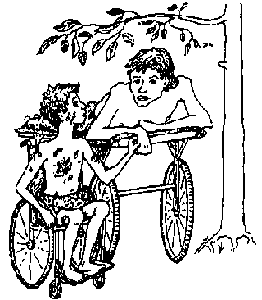
QUIQUE AND JOSÉ. Not long ago, a 7-year-old
brain-injured boy named José was temporarily abandoned by his family at
PROJIMO. Limited by extensive physical and mental handicap, José was
fretful and unresponsive. He had no urine or bowel control. Repeated
attempts to toilet train him failed. Whenever his bowels moved (too
often!) he smeared his feces (shit) over his body, face and hair. Even
PROJIMO's coordinators, Mari and Conchita, who are themselves disabled and
usually very loving with disabled children, were at the end of their wits
and patience with José.
Then an amazing thing happened: a friendship developed between José and
Quique. Quique, a young man paralyzed from the neck down (quadriplegic),
had an angry, belligerent temper. Repeatedly he was expelled from PROJIMO
for drug dealing, drunkenness, and trouble-making. One day Quique was
lying on his gurney under a mango tree when, unexpectedly, he and little
José began to communicate. José could not speak, but somehow Quique caught
his interest. When Quique talked to him - not as a misfit but as a friend
- the boy began to grunt and eventually smile. With effort José rolled his
wheelchair next to Quique and slipped his filthy little fingers into
Quique's gaunt, paralyzed hand. From that moment the two were inseparable.
Quique assumed a protective responsibility for José. He demanded that
the boy be bathed when he dirtied himself, and gently encouraged him to
wash his own hands and feed himself. José began to show improvement in
many ways, and smeared himself with his feces less often. Both he and
Quique seemed happier.
Quique's strangely insightful, caring response to José was not unusual.
Time and again, disabled youth who arrive socially scarred and violent
have become among the most considerate care providers for those in
greatest need.
Some of the most lovingly conceived innovations in this book were
created by young disabled persons
who emerged from the sub-culture of drug-trafficking and violence.
|
| 004
|
PROJIMO's Involvement With Innovative Participatory Technology
Toward the end of 1990, PROJIMO received a three year grant for
Innovative Research from the Thrasher Research Fund in North America.
Many of the innovations in this book were developed during this grant
period, while some were developed before or after. In addition, to
emphasize important points, a few innovations are included from other
regions, ranging from India to Bangladesh and from Zimbabwe to Belize
and Brazil.
Many of the innovations presented in this book have been
developed by the PROJIMO team together with 3 sorts of
participants:
- Disabled persons and family members have
been central to the problem solving process. Designs have been
created to meet the expressed needs of disabled individuals and
have been adapted, on their terms, to local social and
environmental conditions, economic limitations, and locally
available resources.
- Participants from community rehabilitation and
disability programs in Mexico and Central America have
taken part in designing and building innovative aids during
short workshops and "educational
exchanges." Most of the participants were themselves
disabled. Having a disability was considered a valued
qualification, both for learners and facilitators. In this way,
the methodology and "mystique" of the innovative approach has
been widely shared.
|

Ralf Hotchkiss, a wheelchair-riding engineer
from California, with Concepción in a chair made in a
wheelchair-making workshop at PROJIMO. Ralf has helped to design
many great innovations together with disabled Third World
wheelchair builders (see Chapter 30).
|
- Volunteers from Europe, Latin America, the USA and
elsewhere, many of them innovators and experts in their
respective fields, took part in most of these short workshops and
mini-courses. They included prosthetists (leg makers), orthotists
(brace makers), seating specialists, wheelchair designers,
physical and occupational therapists, and instructors in early
development and special education. Many (but not all) of these
visiting specialists were also disabled. All came with an
understanding that their role was to teach rather than to
provide services, and to work as partners and equals with local
rehabilitation workers (mostly disabled villagers) and with
disabled clients and their families.
|
As a result of this unique combination of disabled community
rehabilitation workers and disabled clients working together with
visiting apprentices and outside specialists, many of the innovations
described in this book have been created through a cooperative,
equalizing process. As readers will notice, a lot of these aids and
devices combine scientific sophistication and grassroots simplicity.
This sort of collective problem-solving process teaches us a
lot. Above all, we learn to respect one another's contrasting insights
and skills. |
| 005
|
DISABLED PERSONS MAKE MAJOR BREAKTHROUGHS IN DESIGNS
| A lot of professionals are unwilling to include
disabled persons as partners in designing solutions to their needs,
and often disabled persons are reluctant to assume such
responsibility. Nevertheless: Many major breakthroughs in
rehabilitation technology
have been designed and created by disabled people themselves.
For blind people, of course, the most famous
breakthrough was a brilliantly simple form of reading tiny raised
dots with the finger-tips. This was invented by a blind French boy,
Louis Braille. Rather than supporting his innovation, his teachers
in the School for the Blind punished Louis and his classmates for
experimenting with his new system. So they used it in secret! For
those in positions of authority, it is often difficult when persons
under their control take the lead. In every sense the
invention of Braille was revolutionary - and for blind people it was
liberating.
In recent years many of the most outstanding designs of
communications aids, wheelchairs, and limbs have been developed by
wheelchair riders, amputees, and other disabled persons.
Dissatisfied with the equipment available to them, these persons
invented something better.
A major breakthrough in artificial limbs is the
flex foot, which was invented by an amputee. When
the person walks, the flexible foot-piece acts like a spring,
simulating the push-off action of a normal foot. This makes walking
easier, smoother, faster, and it takes less energy. |

Louis Braille invented this dot alphabet at
age 14. The dots are pressed into a thick paper from the opposite
side with a pointed tool called a 'stylus'.
|
|

|
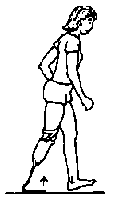
|
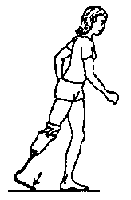
|
| The lower leg and foot
are made of a curved thin strip of carbon fiber,
a strong, flexible space-age material. |
The foot-piece bends
more when the person steps on it, in effect loading the spring. |
At the end of the
step, the foot-piece gives a downward and forward push, propelling
the person forward. |
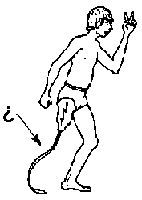
John Fago, a professional photographer who has an artificial leg,
studied limb-making after visiting PROJIMO and then started making his
own leg. Concerned more with function than appearance, he is designing
a flex leg shaped like an upside-down question mark:
¿
The entire leg acts like a spring, giving the user a powerful forward
thrust. Also - with the help of a man who designs bamboo fishing poles
- John is experimenting with making a flex foot out of
laminated bamboo, instead of costly carbon fiber. His goal is
to help poor communities to make flex-feet with local resources at low
cost.
|
| 006
|
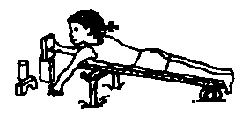
TECHNICAL AIDS AND EQUIPMENT ARE IMPORTANT
One reason for writing this book is that in many programs for
disabled people in poor countries and communities, too little
attention is given to technical aids and assistive equipment.
The current trend is to down-play the technological side of
rehabilitation. This comes both from disabled people's organizations
and from planners of community based rehabilitation (CBR) programs:
 | Disabled activists and organizations in the
North are passionately concerned with disability rights. In their
struggle to achieve a Society for All, they focus
on social issues such as accessibility, equal opportunity for
education, jobs, etc. They are less worried about technical aids.
After all, most members of leading disabled people's organizations,
especially in the North - and of Disabled Person's International,
even in the South - belong to the middle class. They already have
the essential personal aids they need. So their top priority is the
struggle for their social rights. They have tended to project their
own priorities onto the poor disabled people of the Third World,
whose lack of assistive equipment (braces, wheelchairs, etc.) may be
their biggest limitation. |
 | The official World Health Organization (WHO) guidelines
for CBR have also (in the past more than at present)
under-emphasized the importance of technical aids. Some CBR
advocates assert that devoting attention to assistive equipment is a
return to the "medical model" of rehabilitation, which they
criticize (in large part, correctly) as being top-down,
professional-dominated, costly, disempowering, and impractical.
Technical information on assistive equipment in the WHO manual tends
to be quite limited and superficial. Much stronger emphasis is
placed on the social side of rehabilitation: schooling, skills
training, job placement, community participation, etc. |
It is true that social considerations are extremely important, and
are still inadequately addressed in most urban "rehabilitation
palaces." But for millions of poor disabled persons, the lack
of low-cost, appropriate mobility aids and assistive equipment is a
major barrier to social integration - including schooling, jobs, and
self-reliant living.
For example, wheelchair accessibility is a big concern for
those who have wheelchairs. But 95 percent of people who need
a wheelchair don't have one. Similarly, many who need leg
braces or artificial limbs to subsist in difficult circumstances don't
have them. Or they are given devices of such poor quality that they
are of questionable benefit.
Appropriate aids can make a huge difference in terms of
self-determination, social integration, and survival. But to
create equipment that is appropriate, we need to work closely with the
disabled persons concerned. We must consider the disabled person's
unique combination of skills, wishes, impairments, opportunities,
income, and motivation, as well as personal and environmental
possibilities and constraints (within home and community). Designs may
differ according to local resources, cost, accessibility, means of
transportation to school or work, and the support system within the
family and community.

ACHIEVING A SOCIETY FOR ALL: NEED FOR AN INTEGRATED
APPROACH
To achieve a society in which disabled people can participate
fully, 3 things are needed:
- Personal rehabilitation and assistive equipment
for improved function and mobility.
- Accessibility in terms of the physical
environment, transportation, etc.
- An accepting, welcoming attitude of the general
population, with readiness to provide equal opportunities.
Supportive legislation can help open doorways to social rights.
Fulfilling only one or two of these requirements is not enough: all
three must be achieved. The need for this integrated three-armed
approach is pictured on the next page.
|
| 007
|
A 'SOCIETY FOR ALL'
can only be achieved through
AN INTEGRATED APPROACH
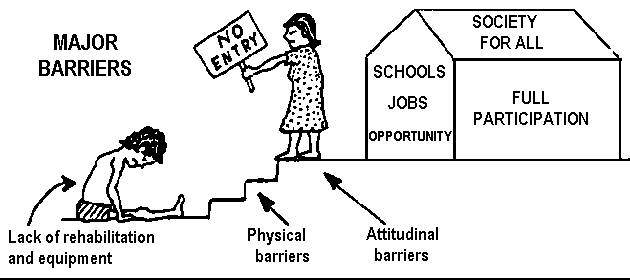
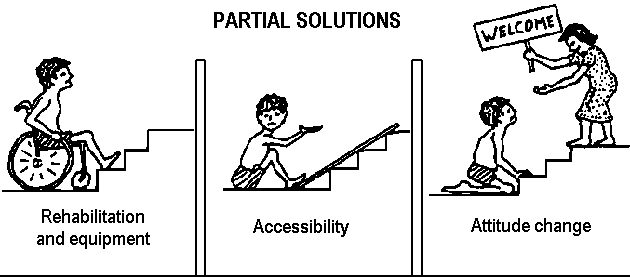
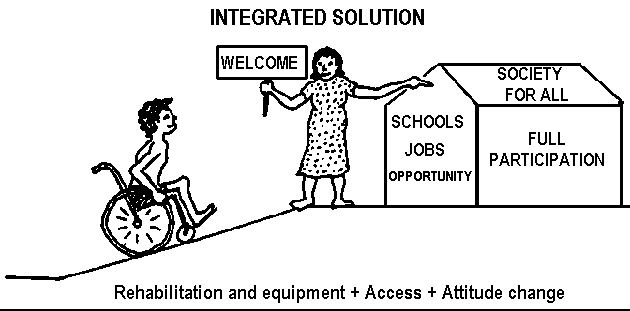
|
| 008
|
POVERTY AND DISABILITY: SURVIVAL COMES FIRST
Persons trained in the field of rehabilitation, as in other
fields, tend to see people's needs in terms of their specialty. A
rehabilitation worker, on seeing a disabled child in an urban slum,
may think first of the child's disability-related needs. The worker
may want to foster an "integrated approach," including assistive
devices, access to schooling, and social involvement. But it is
essential to remember that for that child and millions of other
children, their basic health and survival needs come first.
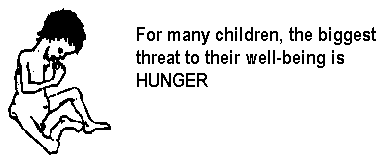
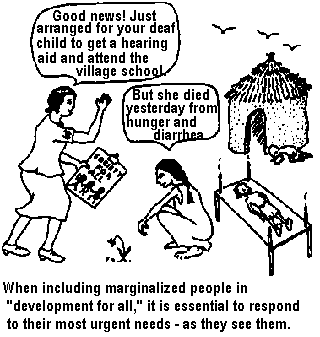
Most important for any child, whether disabled or not, is meeting
her basic needs for food, shelter, and essential health care.
Too often, rehabilitation planners overlook or give too little
attention to the economic limitations of the family. As a result,
sometimes hundreds of dollars are spent on an orthopedic brace,
hearing aid, or on special schooling - only to see the child die
from untreated infection ... or from hunger.
Quite rightly, many community rehabilitation initiatives are
putting more time and energy into helping disabled persons and their
families find ways to produce food or add to their income. For
example, some programs give a goat, rabbits, or chickens to a
disabled child, and help her learn to care for and breed them.
Hard and Soft Technologies
Poverty and disability together put people, especially children,
at double risk. Both must be dealt with. People who are
disadvantaged for whatever reasons need to join in the struggle for
equal rights and full participation in a fairer, more caring society.
Therefore, when we think of "rehabilitation technology," it is
important to consider not just the hard technology of aids
and
equipment, but also the soft technology
of ideas and action that can help disabled persons to
survive, meet their needs, and be more self-determined.
The last two Parts of this book look at innovative soft
technologies. These include activities and methods whereby
disabled people can defend their rights, integrate into society, and
learn skills to earn a living and keep the wolf from their door.

|
| 009 |
Adapting to Extreme Poverty in an African Squatter
Settlement
One of the most innovative community based rehabilitation (CBR)
programs that I (the author) have visited is in a huge shanty town
called Matari Valley, in Nairobi, Kenya. This settlement was formed
in colonial times by young women from rural areas who worked in the
city as house girls and mistresses for white masters. When the girls
got pregnant, they were thrown onto the streets and settled in
Matari Valley. Today hundreds of thousands of single mothers survive
there by brewing illegal liquor, selling their bodies, begging, and
picking through garbage. A large number of children are disabled.
Many mothers leave their disabled child shut up all day, sweltering
in tar-paper shacks. The mothers do this, not by choice, but in
their efforts to earn enough to feed their children at least one
meal a day.
A CBR worker named Penina, who went to Matari Valley several
years ago found that the first concern of mothers with disabled
children was not "rehabilitation," assistive equipment, or
schooling. Their worries had to do with food, sickness, and
survival.

So Penina modified her rehabilitation plans. She put the survival
and basic needs of the children first. She began by looking for ways
to help mothers earn a little income in their homes, so that
they could spend more time with their children. At times
this meant giving mothers small loans to start selling lamp oil or
charcoal. She helped groups of mothers form child-care
cooperatives, so that they could take turns caring for one
another's children while the rest sought outside work. She then
helped mothers form sewing, chicken-raising and other small
work cooperatives to produce an income and have
shared child-care where they work.
Once the mothers were earning a bit more income, they could feed
their children better and spend more time with them. So Penina began
to introduce early stimulation and developmental activities
into the child-care groups. From among those mothers who showed the
most interest, love, and natural ability, she trained several to
help as facilitators, teachers, and neighborhood rehabilitation
assistants.
As day-to-day survival became less of a struggle, the mothers
were able to devote more time to assisting their disabled children.
Penina began to teach the mothers exercises and activities they
could do in the home to help their children learn skills and become
more independent. As much as was possible given the limited
resources, she helped them to access the aids and services that they
needed.
As the mothers began to see signs of improvements in their
children, they confidence grew, both in themselves and in the
potential of their children.
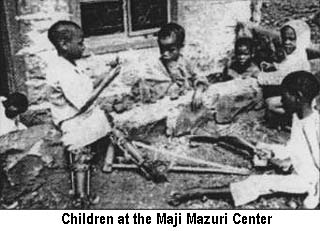
Eventually the mothers, with help from neighbors, built a modest
community center (called Maji Mazuri) for meetings,
rehabilitation, skills training, income generation, games,
awareness-raising theater skits, and child-care. The women also
built a cooperative bakery. The initiative for disabled
children became a spearhead for community development. |
|